Critical Appraisal of Randomised Control Trial
VerifiedAdded on 2023/01/18
|9
|2112
|52
AI Summary
This document provides a critical appraisal of a randomised control trial on the effect of a nurse empowerment educational program on patient safety culture. It evaluates the validity of the trial, treatment effects, and applicability to the local population. The document also discusses the benefits and costs of implementing the results.
Contribute Materials
Your contribution can guide someone’s learning journey. Share your
documents today.
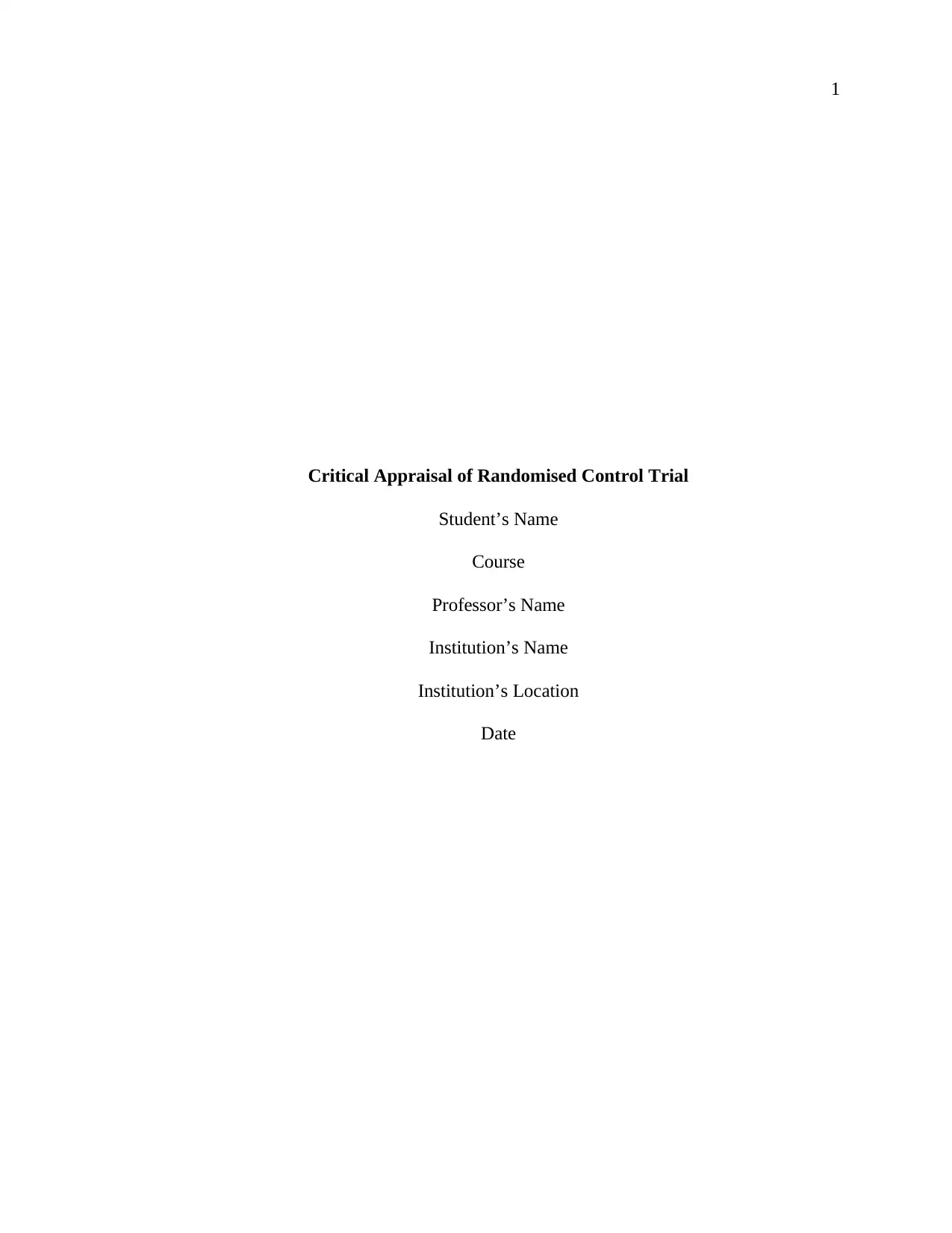
1
Critical Appraisal of Randomised Control Trial
Student’s Name
Course
Professor’s Name
Institution’s Name
Institution’s Location
Date
Critical Appraisal of Randomised Control Trial
Student’s Name
Course
Professor’s Name
Institution’s Name
Institution’s Location
Date
Secure Best Marks with AI Grader
Need help grading? Try our AI Grader for instant feedback on your assignments.
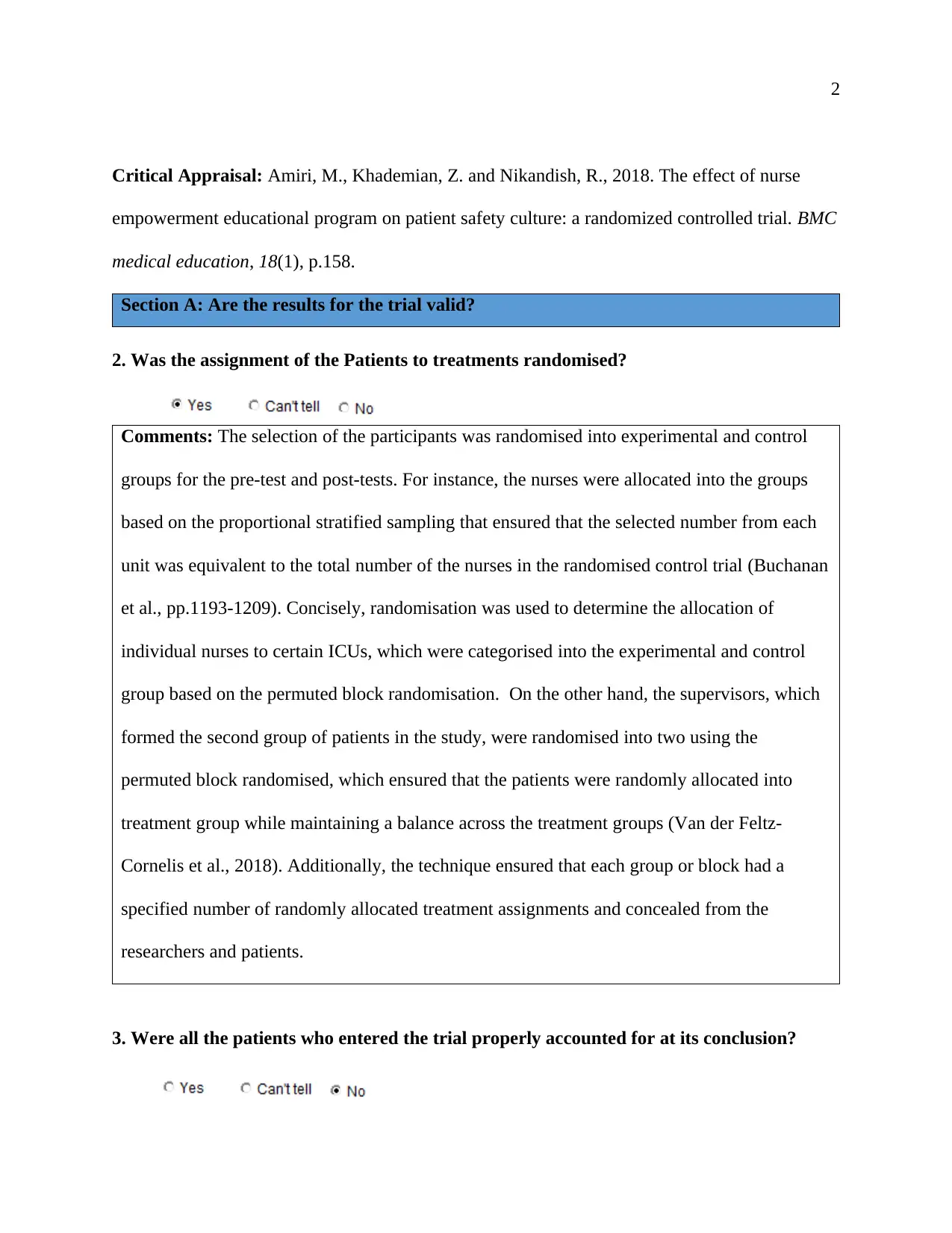
2
Critical Appraisal: Amiri, M., Khademian, Z. and Nikandish, R., 2018. The effect of nurse
empowerment educational program on patient safety culture: a randomized controlled trial. BMC
medical education, 18(1), p.158.
Section A: Are the results for the trial valid?
2. Was the assignment of the Patients to treatments randomised?
Comments: The selection of the participants was randomised into experimental and control
groups for the pre-test and post-tests. For instance, the nurses were allocated into the groups
based on the proportional stratified sampling that ensured that the selected number from each
unit was equivalent to the total number of the nurses in the randomised control trial (Buchanan
et al., pp.1193-1209). Concisely, randomisation was used to determine the allocation of
individual nurses to certain ICUs, which were categorised into the experimental and control
group based on the permuted block randomisation. On the other hand, the supervisors, which
formed the second group of patients in the study, were randomised into two using the
permuted block randomised, which ensured that the patients were randomly allocated into
treatment group while maintaining a balance across the treatment groups (Van der Feltz-
Cornelis et al., 2018). Additionally, the technique ensured that each group or block had a
specified number of randomly allocated treatment assignments and concealed from the
researchers and patients.
3. Were all the patients who entered the trial properly accounted for at its conclusion?
Critical Appraisal: Amiri, M., Khademian, Z. and Nikandish, R., 2018. The effect of nurse
empowerment educational program on patient safety culture: a randomized controlled trial. BMC
medical education, 18(1), p.158.
Section A: Are the results for the trial valid?
2. Was the assignment of the Patients to treatments randomised?
Comments: The selection of the participants was randomised into experimental and control
groups for the pre-test and post-tests. For instance, the nurses were allocated into the groups
based on the proportional stratified sampling that ensured that the selected number from each
unit was equivalent to the total number of the nurses in the randomised control trial (Buchanan
et al., pp.1193-1209). Concisely, randomisation was used to determine the allocation of
individual nurses to certain ICUs, which were categorised into the experimental and control
group based on the permuted block randomisation. On the other hand, the supervisors, which
formed the second group of patients in the study, were randomised into two using the
permuted block randomised, which ensured that the patients were randomly allocated into
treatment group while maintaining a balance across the treatment groups (Van der Feltz-
Cornelis et al., 2018). Additionally, the technique ensured that each group or block had a
specified number of randomly allocated treatment assignments and concealed from the
researchers and patients.
3. Were all the patients who entered the trial properly accounted for at its conclusion?
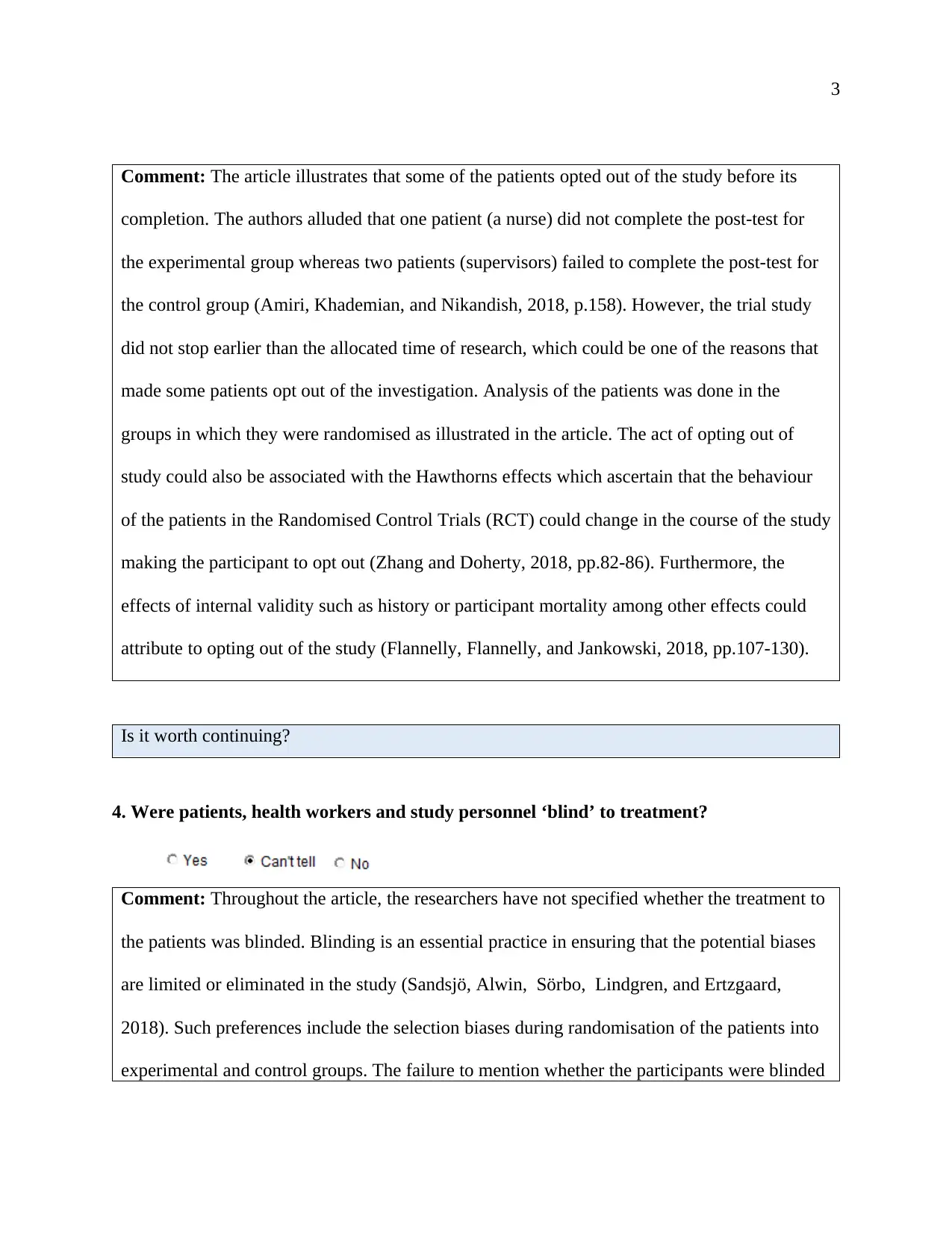
3
Comment: The article illustrates that some of the patients opted out of the study before its
completion. The authors alluded that one patient (a nurse) did not complete the post-test for
the experimental group whereas two patients (supervisors) failed to complete the post-test for
the control group (Amiri, Khademian, and Nikandish, 2018, p.158). However, the trial study
did not stop earlier than the allocated time of research, which could be one of the reasons that
made some patients opt out of the investigation. Analysis of the patients was done in the
groups in which they were randomised as illustrated in the article. The act of opting out of
study could also be associated with the Hawthorns effects which ascertain that the behaviour
of the patients in the Randomised Control Trials (RCT) could change in the course of the study
making the participant to opt out (Zhang and Doherty, 2018, pp.82-86). Furthermore, the
effects of internal validity such as history or participant mortality among other effects could
attribute to opting out of the study (Flannelly, Flannelly, and Jankowski, 2018, pp.107-130).
Is it worth continuing?
4. Were patients, health workers and study personnel ‘blind’ to treatment?
Comment: Throughout the article, the researchers have not specified whether the treatment to
the patients was blinded. Blinding is an essential practice in ensuring that the potential biases
are limited or eliminated in the study (Sandsjö, Alwin, Sörbo, Lindgren, and Ertzgaard,
2018). Such preferences include the selection biases during randomisation of the patients into
experimental and control groups. The failure to mention whether the participants were blinded
Comment: The article illustrates that some of the patients opted out of the study before its
completion. The authors alluded that one patient (a nurse) did not complete the post-test for
the experimental group whereas two patients (supervisors) failed to complete the post-test for
the control group (Amiri, Khademian, and Nikandish, 2018, p.158). However, the trial study
did not stop earlier than the allocated time of research, which could be one of the reasons that
made some patients opt out of the investigation. Analysis of the patients was done in the
groups in which they were randomised as illustrated in the article. The act of opting out of
study could also be associated with the Hawthorns effects which ascertain that the behaviour
of the patients in the Randomised Control Trials (RCT) could change in the course of the study
making the participant to opt out (Zhang and Doherty, 2018, pp.82-86). Furthermore, the
effects of internal validity such as history or participant mortality among other effects could
attribute to opting out of the study (Flannelly, Flannelly, and Jankowski, 2018, pp.107-130).
Is it worth continuing?
4. Were patients, health workers and study personnel ‘blind’ to treatment?
Comment: Throughout the article, the researchers have not specified whether the treatment to
the patients was blinded. Blinding is an essential practice in ensuring that the potential biases
are limited or eliminated in the study (Sandsjö, Alwin, Sörbo, Lindgren, and Ertzgaard,
2018). Such preferences include the selection biases during randomisation of the patients into
experimental and control groups. The failure to mention whether the participants were blinded
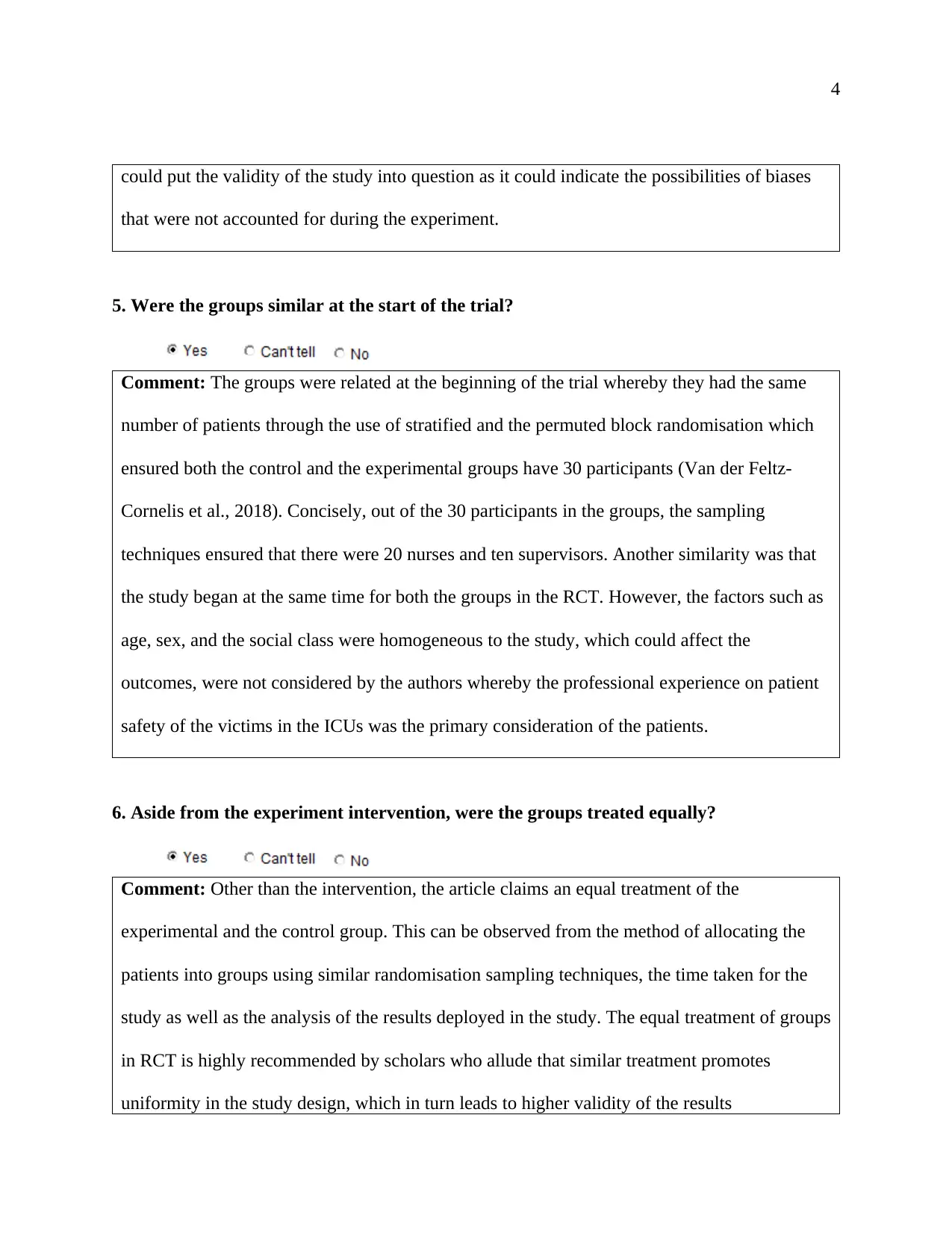
4
could put the validity of the study into question as it could indicate the possibilities of biases
that were not accounted for during the experiment.
5. Were the groups similar at the start of the trial?
Comment: The groups were related at the beginning of the trial whereby they had the same
number of patients through the use of stratified and the permuted block randomisation which
ensured both the control and the experimental groups have 30 participants (Van der Feltz-
Cornelis et al., 2018). Concisely, out of the 30 participants in the groups, the sampling
techniques ensured that there were 20 nurses and ten supervisors. Another similarity was that
the study began at the same time for both the groups in the RCT. However, the factors such as
age, sex, and the social class were homogeneous to the study, which could affect the
outcomes, were not considered by the authors whereby the professional experience on patient
safety of the victims in the ICUs was the primary consideration of the patients.
6. Aside from the experiment intervention, were the groups treated equally?
Comment: Other than the intervention, the article claims an equal treatment of the
experimental and the control group. This can be observed from the method of allocating the
patients into groups using similar randomisation sampling techniques, the time taken for the
study as well as the analysis of the results deployed in the study. The equal treatment of groups
in RCT is highly recommended by scholars who allude that similar treatment promotes
uniformity in the study design, which in turn leads to higher validity of the results
could put the validity of the study into question as it could indicate the possibilities of biases
that were not accounted for during the experiment.
5. Were the groups similar at the start of the trial?
Comment: The groups were related at the beginning of the trial whereby they had the same
number of patients through the use of stratified and the permuted block randomisation which
ensured both the control and the experimental groups have 30 participants (Van der Feltz-
Cornelis et al., 2018). Concisely, out of the 30 participants in the groups, the sampling
techniques ensured that there were 20 nurses and ten supervisors. Another similarity was that
the study began at the same time for both the groups in the RCT. However, the factors such as
age, sex, and the social class were homogeneous to the study, which could affect the
outcomes, were not considered by the authors whereby the professional experience on patient
safety of the victims in the ICUs was the primary consideration of the patients.
6. Aside from the experiment intervention, were the groups treated equally?
Comment: Other than the intervention, the article claims an equal treatment of the
experimental and the control group. This can be observed from the method of allocating the
patients into groups using similar randomisation sampling techniques, the time taken for the
study as well as the analysis of the results deployed in the study. The equal treatment of groups
in RCT is highly recommended by scholars who allude that similar treatment promotes
uniformity in the study design, which in turn leads to higher validity of the results
Secure Best Marks with AI Grader
Need help grading? Try our AI Grader for instant feedback on your assignments.
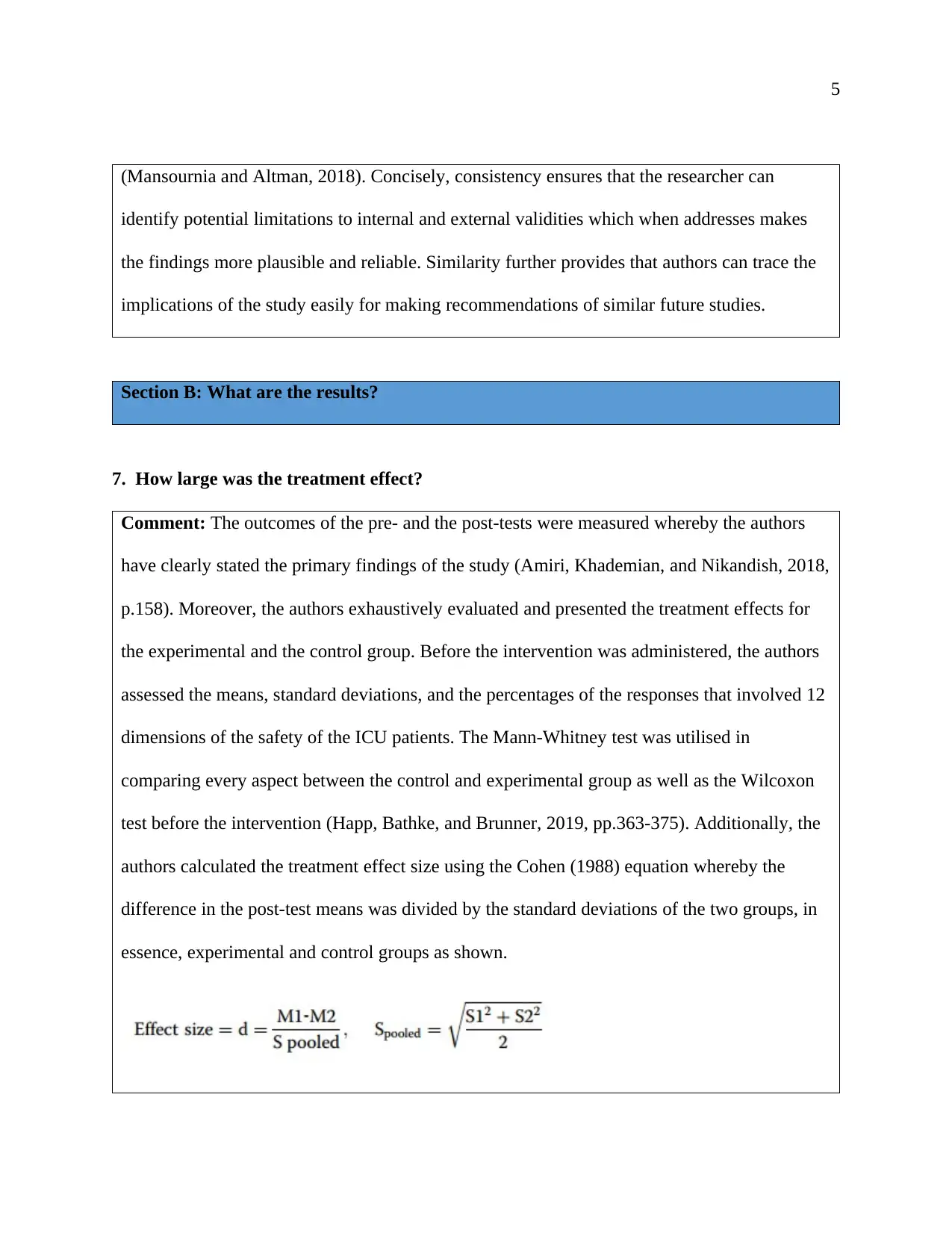
5
(Mansournia and Altman, 2018). Concisely, consistency ensures that the researcher can
identify potential limitations to internal and external validities which when addresses makes
the findings more plausible and reliable. Similarity further provides that authors can trace the
implications of the study easily for making recommendations of similar future studies.
Section B: What are the results?
7. How large was the treatment effect?
Comment: The outcomes of the pre- and the post-tests were measured whereby the authors
have clearly stated the primary findings of the study (Amiri, Khademian, and Nikandish, 2018,
p.158). Moreover, the authors exhaustively evaluated and presented the treatment effects for
the experimental and the control group. Before the intervention was administered, the authors
assessed the means, standard deviations, and the percentages of the responses that involved 12
dimensions of the safety of the ICU patients. The Mann-Whitney test was utilised in
comparing every aspect between the control and experimental group as well as the Wilcoxon
test before the intervention (Happ, Bathke, and Brunner, 2019, pp.363-375). Additionally, the
authors calculated the treatment effect size using the Cohen (1988) equation whereby the
difference in the post-test means was divided by the standard deviations of the two groups, in
essence, experimental and control groups as shown.
(Mansournia and Altman, 2018). Concisely, consistency ensures that the researcher can
identify potential limitations to internal and external validities which when addresses makes
the findings more plausible and reliable. Similarity further provides that authors can trace the
implications of the study easily for making recommendations of similar future studies.
Section B: What are the results?
7. How large was the treatment effect?
Comment: The outcomes of the pre- and the post-tests were measured whereby the authors
have clearly stated the primary findings of the study (Amiri, Khademian, and Nikandish, 2018,
p.158). Moreover, the authors exhaustively evaluated and presented the treatment effects for
the experimental and the control group. Before the intervention was administered, the authors
assessed the means, standard deviations, and the percentages of the responses that involved 12
dimensions of the safety of the ICU patients. The Mann-Whitney test was utilised in
comparing every aspect between the control and experimental group as well as the Wilcoxon
test before the intervention (Happ, Bathke, and Brunner, 2019, pp.363-375). Additionally, the
authors calculated the treatment effect size using the Cohen (1988) equation whereby the
difference in the post-test means was divided by the standard deviations of the two groups, in
essence, experimental and control groups as shown.
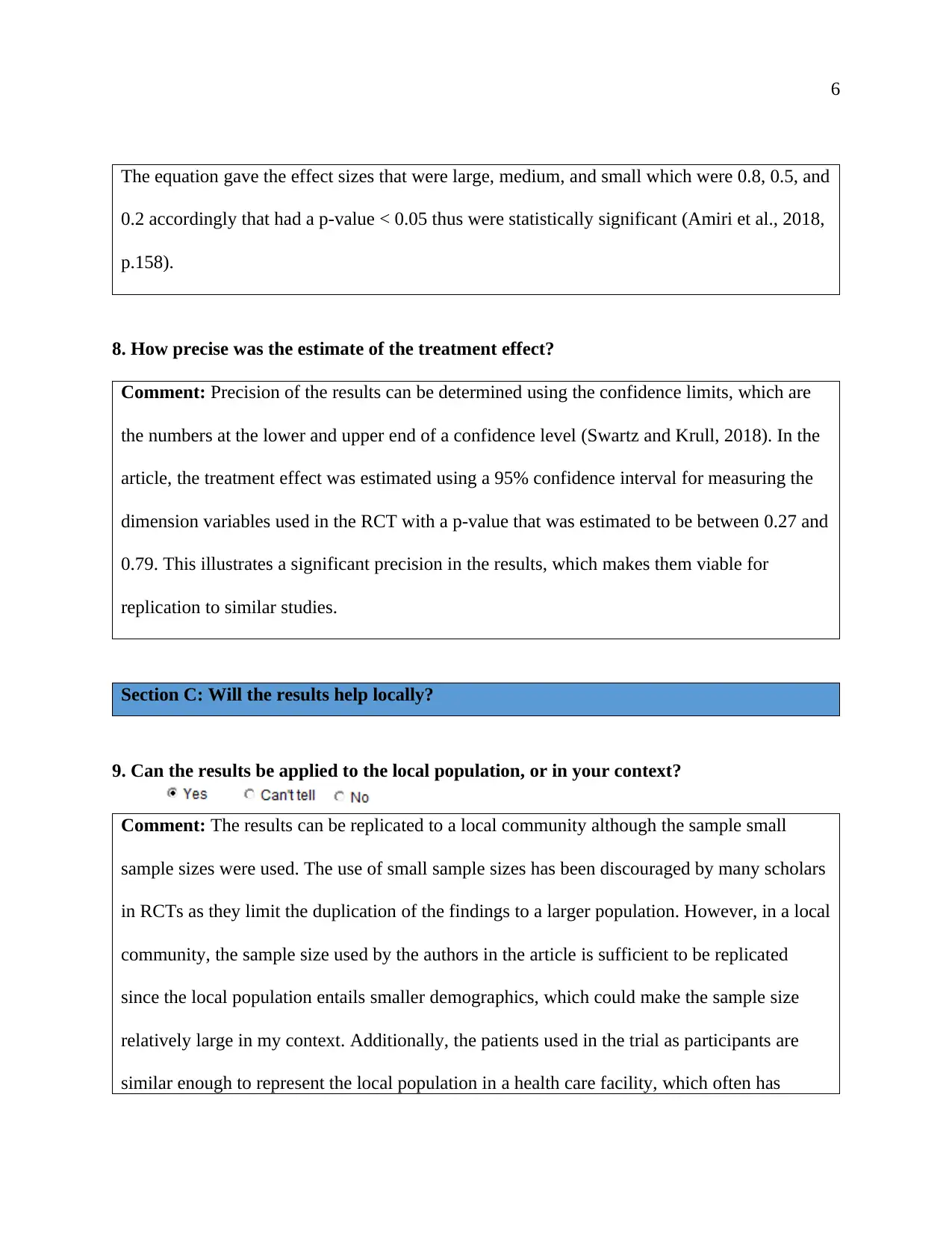
6
The equation gave the effect sizes that were large, medium, and small which were 0.8, 0.5, and
0.2 accordingly that had a p-value ˂ 0.05 thus were statistically significant (Amiri et al., 2018,
p.158).
8. How precise was the estimate of the treatment effect?
Comment: Precision of the results can be determined using the confidence limits, which are
the numbers at the lower and upper end of a confidence level (Swartz and Krull, 2018). In the
article, the treatment effect was estimated using a 95% confidence interval for measuring the
dimension variables used in the RCT with a p-value that was estimated to be between 0.27 and
0.79. This illustrates a significant precision in the results, which makes them viable for
replication to similar studies.
Section C: Will the results help locally?
9. Can the results be applied to the local population, or in your context?
Comment: The results can be replicated to a local community although the sample small
sample sizes were used. The use of small sample sizes has been discouraged by many scholars
in RCTs as they limit the duplication of the findings to a larger population. However, in a local
community, the sample size used by the authors in the article is sufficient to be replicated
since the local population entails smaller demographics, which could make the sample size
relatively large in my context. Additionally, the patients used in the trial as participants are
similar enough to represent the local population in a health care facility, which often has
The equation gave the effect sizes that were large, medium, and small which were 0.8, 0.5, and
0.2 accordingly that had a p-value ˂ 0.05 thus were statistically significant (Amiri et al., 2018,
p.158).
8. How precise was the estimate of the treatment effect?
Comment: Precision of the results can be determined using the confidence limits, which are
the numbers at the lower and upper end of a confidence level (Swartz and Krull, 2018). In the
article, the treatment effect was estimated using a 95% confidence interval for measuring the
dimension variables used in the RCT with a p-value that was estimated to be between 0.27 and
0.79. This illustrates a significant precision in the results, which makes them viable for
replication to similar studies.
Section C: Will the results help locally?
9. Can the results be applied to the local population, or in your context?
Comment: The results can be replicated to a local community although the sample small
sample sizes were used. The use of small sample sizes has been discouraged by many scholars
in RCTs as they limit the duplication of the findings to a larger population. However, in a local
community, the sample size used by the authors in the article is sufficient to be replicated
since the local population entails smaller demographics, which could make the sample size
relatively large in my context. Additionally, the patients used in the trial as participants are
similar enough to represent the local population in a health care facility, which often has
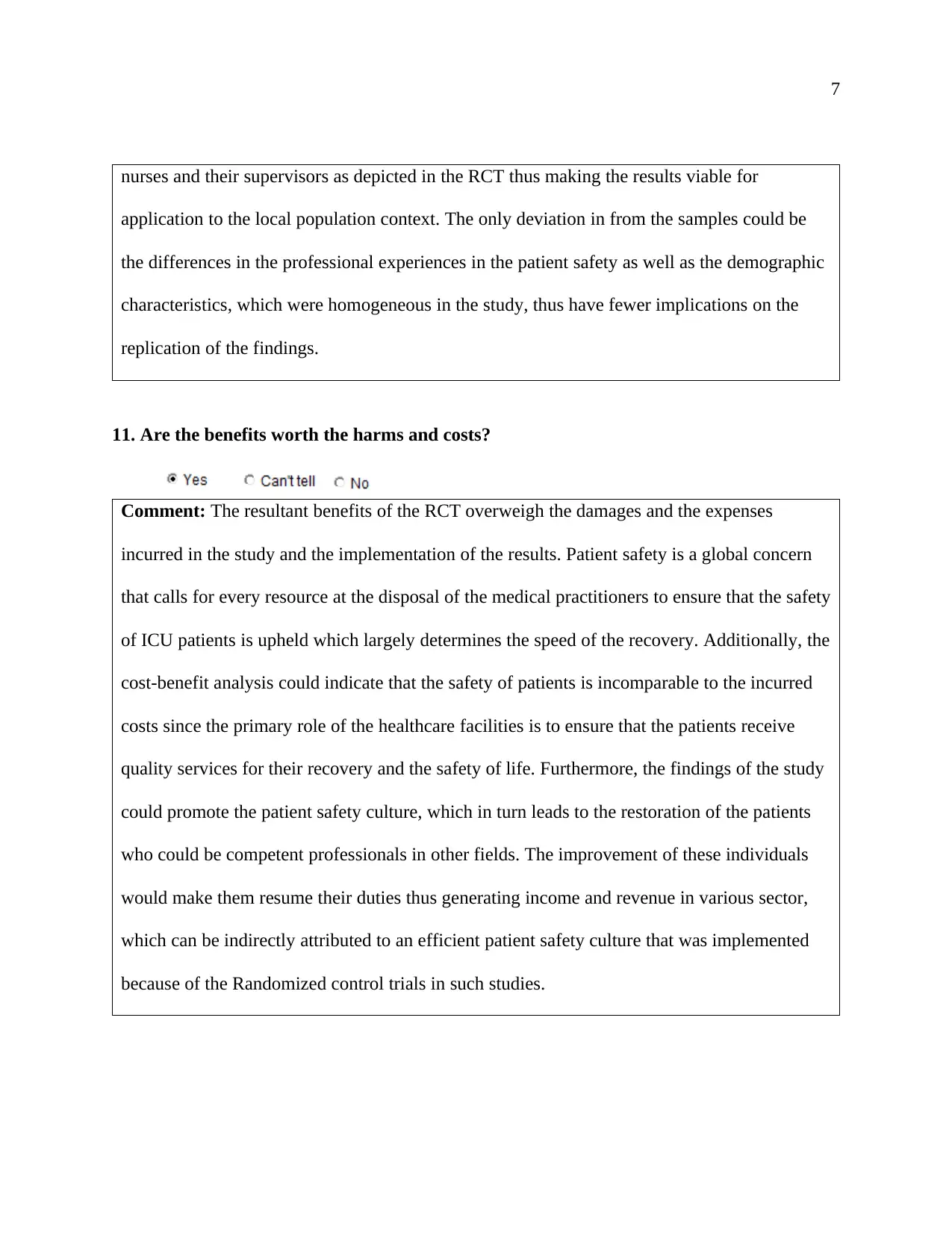
7
nurses and their supervisors as depicted in the RCT thus making the results viable for
application to the local population context. The only deviation in from the samples could be
the differences in the professional experiences in the patient safety as well as the demographic
characteristics, which were homogeneous in the study, thus have fewer implications on the
replication of the findings.
11. Are the benefits worth the harms and costs?
Comment: The resultant benefits of the RCT overweigh the damages and the expenses
incurred in the study and the implementation of the results. Patient safety is a global concern
that calls for every resource at the disposal of the medical practitioners to ensure that the safety
of ICU patients is upheld which largely determines the speed of the recovery. Additionally, the
cost-benefit analysis could indicate that the safety of patients is incomparable to the incurred
costs since the primary role of the healthcare facilities is to ensure that the patients receive
quality services for their recovery and the safety of life. Furthermore, the findings of the study
could promote the patient safety culture, which in turn leads to the restoration of the patients
who could be competent professionals in other fields. The improvement of these individuals
would make them resume their duties thus generating income and revenue in various sector,
which can be indirectly attributed to an efficient patient safety culture that was implemented
because of the Randomized control trials in such studies.
nurses and their supervisors as depicted in the RCT thus making the results viable for
application to the local population context. The only deviation in from the samples could be
the differences in the professional experiences in the patient safety as well as the demographic
characteristics, which were homogeneous in the study, thus have fewer implications on the
replication of the findings.
11. Are the benefits worth the harms and costs?
Comment: The resultant benefits of the RCT overweigh the damages and the expenses
incurred in the study and the implementation of the results. Patient safety is a global concern
that calls for every resource at the disposal of the medical practitioners to ensure that the safety
of ICU patients is upheld which largely determines the speed of the recovery. Additionally, the
cost-benefit analysis could indicate that the safety of patients is incomparable to the incurred
costs since the primary role of the healthcare facilities is to ensure that the patients receive
quality services for their recovery and the safety of life. Furthermore, the findings of the study
could promote the patient safety culture, which in turn leads to the restoration of the patients
who could be competent professionals in other fields. The improvement of these individuals
would make them resume their duties thus generating income and revenue in various sector,
which can be indirectly attributed to an efficient patient safety culture that was implemented
because of the Randomized control trials in such studies.
Paraphrase This Document
Need a fresh take? Get an instant paraphrase of this document with our AI Paraphraser
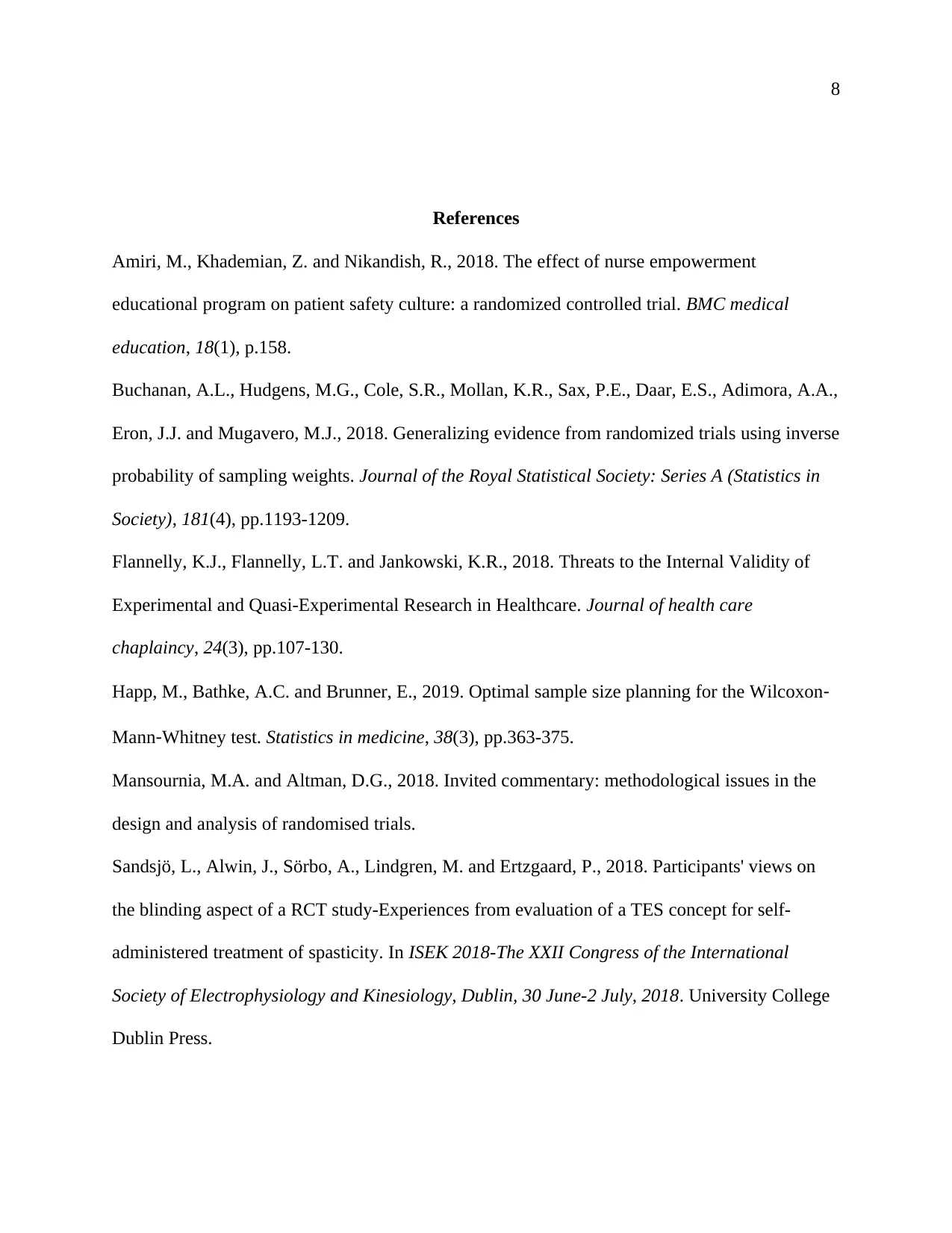
8
References
Amiri, M., Khademian, Z. and Nikandish, R., 2018. The effect of nurse empowerment
educational program on patient safety culture: a randomized controlled trial. BMC medical
education, 18(1), p.158.
Buchanan, A.L., Hudgens, M.G., Cole, S.R., Mollan, K.R., Sax, P.E., Daar, E.S., Adimora, A.A.,
Eron, J.J. and Mugavero, M.J., 2018. Generalizing evidence from randomized trials using inverse
probability of sampling weights. Journal of the Royal Statistical Society: Series A (Statistics in
Society), 181(4), pp.1193-1209.
Flannelly, K.J., Flannelly, L.T. and Jankowski, K.R., 2018. Threats to the Internal Validity of
Experimental and Quasi-Experimental Research in Healthcare. Journal of health care
chaplaincy, 24(3), pp.107-130.
Happ, M., Bathke, A.C. and Brunner, E., 2019. Optimal sample size planning for the Wilcoxon‐
Mann‐Whitney test. Statistics in medicine, 38(3), pp.363-375.
Mansournia, M.A. and Altman, D.G., 2018. Invited commentary: methodological issues in the
design and analysis of randomised trials.
Sandsjö, L., Alwin, J., Sörbo, A., Lindgren, M. and Ertzgaard, P., 2018. Participants' views on
the blinding aspect of a RCT study-Experiences from evaluation of a TES concept for self-
administered treatment of spasticity. In ISEK 2018-The XXII Congress of the International
Society of Electrophysiology and Kinesiology, Dublin, 30 June-2 July, 2018. University College
Dublin Press.
References
Amiri, M., Khademian, Z. and Nikandish, R., 2018. The effect of nurse empowerment
educational program on patient safety culture: a randomized controlled trial. BMC medical
education, 18(1), p.158.
Buchanan, A.L., Hudgens, M.G., Cole, S.R., Mollan, K.R., Sax, P.E., Daar, E.S., Adimora, A.A.,
Eron, J.J. and Mugavero, M.J., 2018. Generalizing evidence from randomized trials using inverse
probability of sampling weights. Journal of the Royal Statistical Society: Series A (Statistics in
Society), 181(4), pp.1193-1209.
Flannelly, K.J., Flannelly, L.T. and Jankowski, K.R., 2018. Threats to the Internal Validity of
Experimental and Quasi-Experimental Research in Healthcare. Journal of health care
chaplaincy, 24(3), pp.107-130.
Happ, M., Bathke, A.C. and Brunner, E., 2019. Optimal sample size planning for the Wilcoxon‐
Mann‐Whitney test. Statistics in medicine, 38(3), pp.363-375.
Mansournia, M.A. and Altman, D.G., 2018. Invited commentary: methodological issues in the
design and analysis of randomised trials.
Sandsjö, L., Alwin, J., Sörbo, A., Lindgren, M. and Ertzgaard, P., 2018. Participants' views on
the blinding aspect of a RCT study-Experiences from evaluation of a TES concept for self-
administered treatment of spasticity. In ISEK 2018-The XXII Congress of the International
Society of Electrophysiology and Kinesiology, Dublin, 30 June-2 July, 2018. University College
Dublin Press.
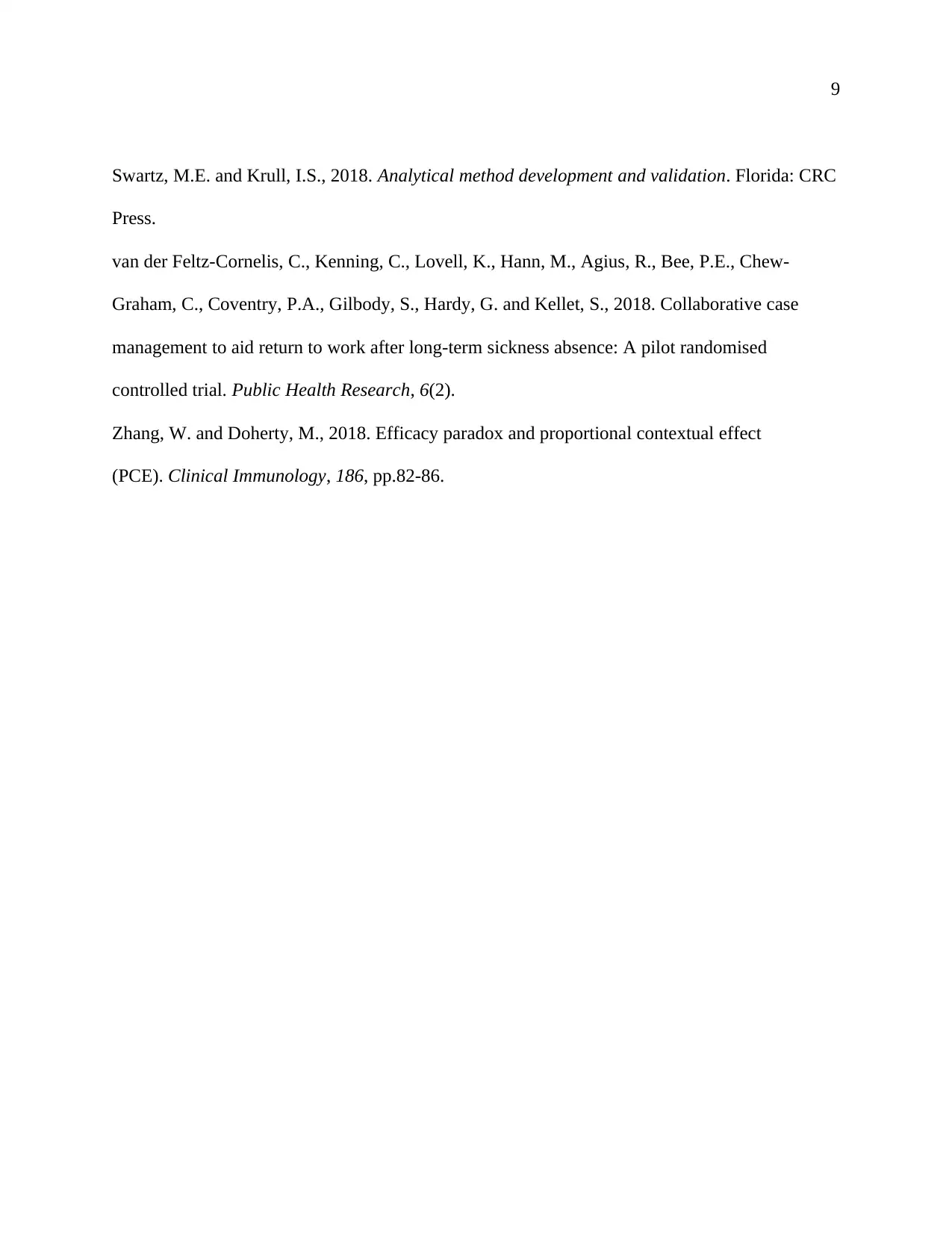
9
Swartz, M.E. and Krull, I.S., 2018. Analytical method development and validation. Florida: CRC
Press.
van der Feltz-Cornelis, C., Kenning, C., Lovell, K., Hann, M., Agius, R., Bee, P.E., Chew-
Graham, C., Coventry, P.A., Gilbody, S., Hardy, G. and Kellet, S., 2018. Collaborative case
management to aid return to work after long-term sickness absence: A pilot randomised
controlled trial. Public Health Research, 6(2).
Zhang, W. and Doherty, M., 2018. Efficacy paradox and proportional contextual effect
(PCE). Clinical Immunology, 186, pp.82-86.
Swartz, M.E. and Krull, I.S., 2018. Analytical method development and validation. Florida: CRC
Press.
van der Feltz-Cornelis, C., Kenning, C., Lovell, K., Hann, M., Agius, R., Bee, P.E., Chew-
Graham, C., Coventry, P.A., Gilbody, S., Hardy, G. and Kellet, S., 2018. Collaborative case
management to aid return to work after long-term sickness absence: A pilot randomised
controlled trial. Public Health Research, 6(2).
Zhang, W. and Doherty, M., 2018. Efficacy paradox and proportional contextual effect
(PCE). Clinical Immunology, 186, pp.82-86.
1 out of 9
Related Documents
Your All-in-One AI-Powered Toolkit for Academic Success.
+13062052269
info@desklib.com
Available 24*7 on WhatsApp / Email
![[object Object]](/_next/static/media/star-bottom.7253800d.svg)
Unlock your academic potential
© 2024 | Zucol Services PVT LTD | All rights reserved.





